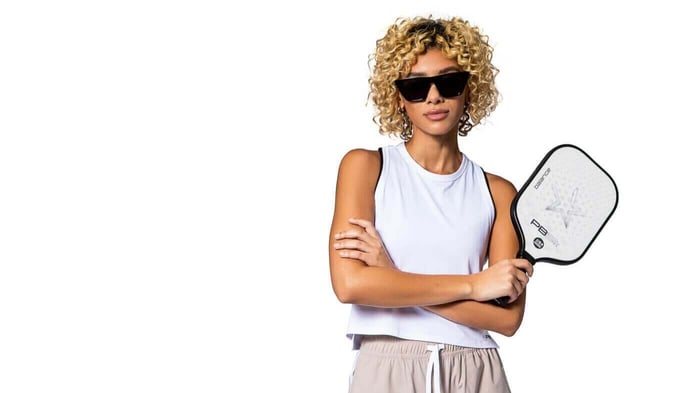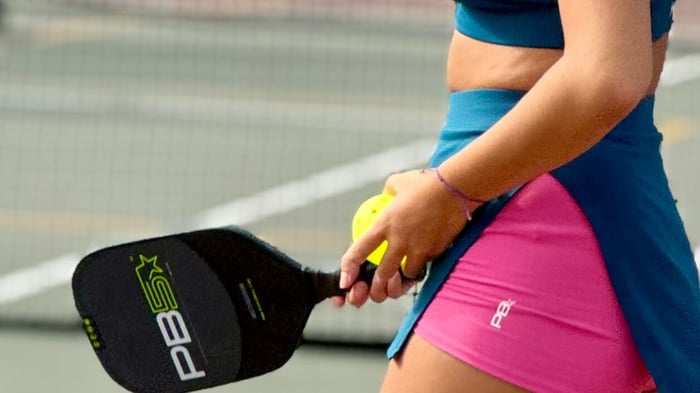Key takeaways:
Proper paddle maintenance can extend the life of your gear and ensure the paddle’s sweet spot stays responsive and consistent.
Storing your paddle in temperature-controlled conditions and checking for damage regularly helps prevent performance decline.
Simple routines like grip replacement, paddle cleaning, and storage protection help your paddle stay match-ready.
That paddle in your hand? It's your ultimate sidekick on the court. But even the best gear needs a little TLC to stay tournament-ready. Proper maintenance can be the difference between a paddle that delivers and one that falls flat mid-game.
When cared for the right way, your paddle can keep its pop and precision for months or even years. Whether you're a seasoned competitor or just picked up your first paddle, you'll benefit from these tried-and-true tips for how to care for your pickleball paddle. Explore PB5star gear that supports your best game every match.
Tip 1: Clean your paddle regularly for peak performance
A clean paddle doesn't just look good. It performs better, shot after shot. Dust, sweat, and ball residue can accumulate fast, especially after intense matches or outdoor play. Over time, this grime dulls the paddle's surface, impacts ball contact, and reduces your ability to generate spin. Keeping it clean isn't optional. It's essential if you want to keep placing those cross-court winners.
After each match, wipe your paddle with a soft microfiber cloth. Focus on the face, grip, and edge guard since these areas trap the most debris.
Once a week, go deeper with a solution of warm water and a few drops of mild soap. Gently clean it with a non-abrasive sponge, then dry it thoroughly with a towel.
For quick cleans between games, use a 2:1 mix of rubbing alcohol and water to sanitize the paddle and keep it fresh.
Always ensure your paddle is completely dry before storing it. Any leftover moisture can degrade the materials and shorten their lifespan.
Tip 2: Give your gear a perfect home
Where you store your paddle matters more than most players realize. Leaving it in your car or near a sunny window may seem harmless, but it can warp materials, fade the finish, or even cause internal damage. If you want your paddle to last, it deserves a proper resting place between matches.
Store your paddle in a climate-controlled area. Avoid garages, trunks, or any location prone to heat or humidity swings.
Use a padded paddle cover to guard against dings, scuffs, and accidental drops. It's like a helmet for your gear.
Before storage, do a quick wipe-down to remove sweat and dust—don't trap moisture inside the case.
Consider mounting a rack or peg system at home to keep your equipment organized and easily accessible.
Never stack paddles; store them upright to prevent any pressure from warping the face.
Tip 3: Conduct routine paddle checks to catch early signs of wear
Think of your paddle as a high-performance tool. Small issues, such as a loose edge guard or a soft grip, can sneak up on you and throw off your game. The sooner you catch them, the easier they are to fix. You're also less likely to end up needing a replacement.
After play, inspect the paddle face for surface scratches, dents, or dead spots that might affect ball response.
Feel around the edge guard. If it's peeling or cracked, it could eventually detach during a match.
Give the grip a light twist. If it shifts or feels too soft, it's time to rewrap or replace it.
Tap the paddle lightly with your knuckles. If the sound is off, you might have internal damage.
A clean paddle is easier to inspect, so make wiping it down part of your post-game ritual.
Make these steps a habit and keep your gear match-ready every time you step onto the court.
Tip 4: Protect your paddle from extreme temperatures
Your paddle's worst enemies? Excessive heat and cold. Heat can cause the adhesive layers to weaken or the surface to warp. Cold can make composite materials brittle. Both extremes mess with your gear's longevity and consistency. Don't leave your paddle at the mercy of the elements.
Never leave your paddle in the car, especially during peak summer or winter days. It's one of the quickest ways to damage the materials.
Keep it away from radiators, vents, or direct sunlight when indoors. These may not seem harmful, but over time they degrade performance.
Invest in an insulated paddle case if you frequently play outdoors or travel with your gear.
Always bring your paddle inside after cold-weather play. Avoid leaving it in a garage or trunk overnight.
A little temperature control goes a long way in keeping your gear solid and dependable.
Tip 5: Maintain the right grip for optimal control
Grip wear is subtle but serious. If it's too slick or worn, you'll lose precision, especially during sweaty rallies or quick exchanges. A fresh grip keeps your paddle feeling secure and gives you the confidence to go for those tricky dinks and overheads.
Wipe the grip with a slightly damp microfiber cloth after each game to clear sweat and grime.
Replace the grip every 100 to 150 hours of play or sooner if it starts feeling flat, smooth, or slippery.
Choose grip thickness based on your hand size: thin grips enhance touch for smaller hands, while thicker ones offer control and cushioning for larger hands.
Try out different grip textures or colors to find one that feels right and matches your vibe on the court.
Great grip = confident play. Never underestimate its impact on your performance.
Tip 6: Rotate your paddles to ensure even wear
Just like rotating your running shoes or restringing your tennis racquet, giving your paddles a break is a smart way to extend their life. Even high-end paddles benefit from a little rest and recovery time between matches.
Rotate between two or more paddles throughout the week to balance wear evenly.
Track how often you use each paddle. Just jotting it down in your bag or phone helps you stay consistent.
Use your best paddle for tournaments or league play and a secondary paddle for practice or casual games.
Share your rotation habits with fellow players. You might learn something new or spark a better system for your whole crew.
Want a deeper dive on paddle rotation? Check out these tips on topspin and gear use
Tip 7: Invest in quality paddles for long-term benefits
The quality of your paddle plays a huge role in how you play and how long your gear holds up. Cheaper paddles may look good at first, but they wear out faster and don't offer the same feel or response. A well-built paddle is a long-term investment in your game.
Opt for paddles made with premium materials like graphite, carbon fiber, or fiberglass. These materials offer better touch, power, and durability.
Go for a lightweight build if you like speed and agility, or choose a slightly heavier paddle for more control and drive.
Pair it with a paddle cover to protect your investment from bumps, weather, and wear.
Choose a paddle that fits your style.
Frequently asked questions about paddle care
Do I need to clean my paddle even if it looks fine?
Yes. Just because your paddle looks clean doesn’t mean it's free of grime or buildup. Sweat, court dust, and oils from your hands can accumulate invisibly and degrade the paddle’s performance. A consistent wipe-down keeps your paddle’s surface responsive and game-ready. Read our paddle cleaning guide.
Is paddle storage really that important?
No doubt about it. Where and how you store your paddle affects everything from its shape to the responsiveness of the face. Leaving it in extreme environments can warp it or wear down the grip. Use a quality paddle case and store your gear indoors in a dry, temperate spot.
How do I know if my paddle has internal damage?
It’s not always visible. If your paddle suddenly feels off or you hear a hollow thud when striking the ball, there may be damage beneath the surface. Vibrations or a “dead” feeling are strong indicators that you should take a closer look at or consider a replacement. Learn when to replace your paddle.
Should I rotate paddles if I only play a few times a month?
Yes. Paddle rotation isn't just for frequent players. Even casual use can create uneven wear patterns over time. Alternating between paddles allows each one to maintain its integrity and responsiveness longer, especially if you're drilling or competing.
Can I customize my grip or do I need a standard replacement?
You can absolutely tailor your grip to your needs. Many players prefer overgrips for added texture or moisture absorption, while others adjust thickness for better hand feel. It’s all about control and comfort. Test a few options to see what works best for your game.
Paddle care: Your path to better play
Taking care of your paddle is one of the smartest moves you can make as a pickleball player. From regular cleaning and temperature-safe storage to grip checks and paddle rotation, these simple habits help keep your gear responsive, powerful, and game-ready. It’s not just about equipment. It’s about giving yourself every advantage to play your best every time you hit the court.
Ready to bring more power, control, and style to your game? Explore PB5star for top-tier paddles, clothes, and accessories that match your passion and performance goals. It’s the gear your game deserves.







